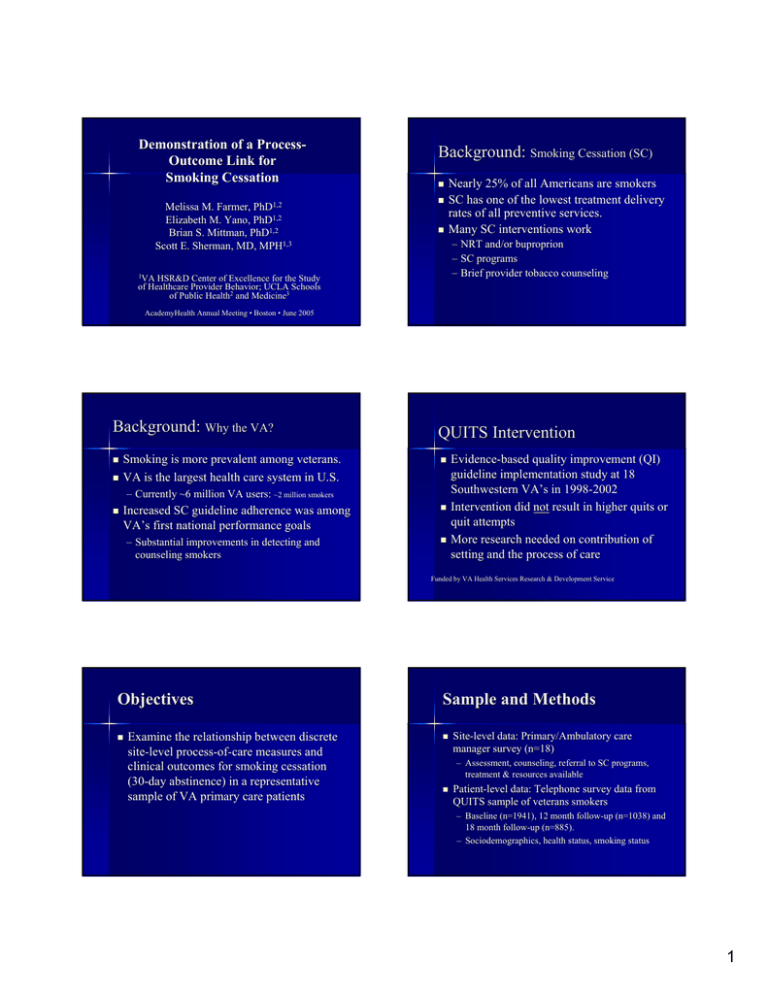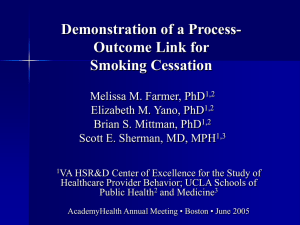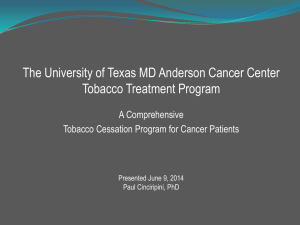Background: Demonstration of a Process - Outcome Link for
advertisement

Demonstration of a ProcessProcessOutcome Link for Smoking Cessation Melissa M. Farmer, PhD1,2 Elizabeth M. Yano, PhD1,2 Brian S. Mittman, PhD1,2 Scott E. Sherman, MD, MPH1,3 Background: Smoking Cessation (SC) Nearly 25% of all Americans are smokers SC has one of the lowest treatment delivery rates of all preventive services. Many SC interventions work – NRT and/or buproprion – SC programs – Brief provider tobacco counseling 1VA HSR&D Center of Excellence for the Study of Healthcare Provider Behavior; UCLA Schools of Public Health2 and Medicine3 AcademyHealth Annual Meeting • Boston • June 2005 Background: Why the VA? Smoking is more prevalent among veterans. VA is the largest health care system in U.S. QUITS Intervention – Currently ~6 million VA users: ~2 million smokers Increased SC guideline adherence was among VA’ VA’s first national performance goals – Substantial improvements in detecting and counseling smokers EvidenceEvidence-based quality improvement (QI) guideline implementation study at 18 Southwestern VA’ VA’s in 19981998-2002 Intervention did not result in higher quits or quit attempts More research needed on contribution of setting and the process of care Funded by VA Health Services Research & Development Service Objectives Examine the relationship between discrete sitesite-level processprocess-ofof-care measures and clinical outcomes for smoking cessation (30(30-day abstinence) in a representative sample of VA primary care patients Sample and Methods SiteSite-level data: Primary/Ambulatory care manager survey (n=18) – Assessment, counseling, referral to SC programs, treatment & resources available PatientPatient-level data: Telephone survey data from QUITS sample of veterans smokers – Baseline (n=1941), 12 month followfollow-up (n=1038) and 18 month followfollow-up (n=885). – Sociodemographics, Sociodemographics, health status, smoking status 1 Analytic Strategy Facility Characteristics (n=18) Logistic regression with clusterclusteradjustment at the sitesite-level to examine processprocess-quality measures as predictors of successful smoking cessation outcomes – controlling for patient characteristics, baseline health and smoking status. % or Mean/SD Variable Assessment of smoking status at visit 41% Counseled at visit* 2.17 (0.54) Referral to specialized SC clinic/program* 1.90 (0.84) Medications prescribed w/out restrictions 31% * 3 point scale: 1=less than half, 2=most, 3=all or almost all patients Facility Characteristics (n=18) Patient Population (n=1038) Variable Variable % % Site measures assessment performance 19% Age (22-91) 57.18 Site measures counseling performance 25% Race: White 64% Routine follow-up for those counseled 44% Self rated health (1=poor-5=excellent) 2.49 Staff reminders to assess smoking status 81% Had made quit attempt at baseline 45% Logistic Model for 30-day abstinence Results Has not smoked cigarette in past 30 days % Abstinence at 12 month followfollow-up 9% Abstinence at 18 month followfollow-up 10% 12-month N=1038 OR (95% CI) 18-month N=885 OR (95% CI) Assessment 2.10(1.15-3.83) 1.87(1.02-3.46) Counsel 1.61(1.01-2.57) 1.58(1.06-2.35) Referral 1.28(1.03-1.59) 1.08(0.86-1.36) Measures assessment 2.38(1.43-3.95) 2.03(1.35-3.03) 2 Summary of Results: Limitations At 1212- months increased odds of abstinence at sites that report more frequent assessment, counseling and referrals. At 1818-months, odds were further increased by sites that report more frequent assessment and counseling. Those sites that monitored their own performance for tobacco use assessment had higher odds of abstinence at 12 and 1818-months. Results limited to QUITS sample of facilities and patients Future research needed on the measurement of processprocess-ofof-care Conclusions and Implications SiteSite-level processprocess-ofof-care measures predict clinical outcomes for smoking cessation. The demonstration of a processprocess-outcome link between smoking cessation performance measures and veterans’ veterans’ actual cessation supports VA’ VA’s process measurement as a valid marker for ultimately helping veterans quit smoking. 3







